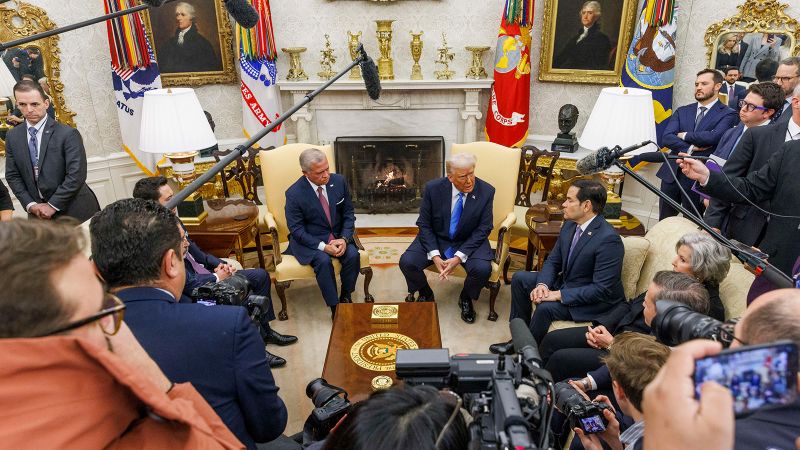What is Hamas and why is it fighting with Israel in Gaza?
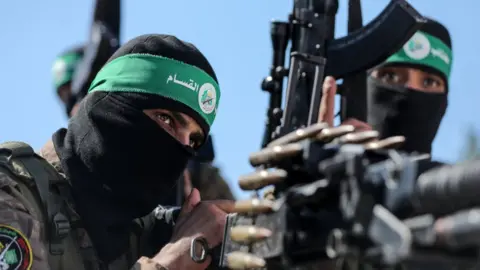 Getty Images
Getty ImagesHamas is a Palestinian armed group and political movement in the Gaza Strip. On 7 October 2023 it attacked Israel, killing about 1,200 people and taking more than 250 hostages.
This triggered a massive Israeli military offensive in Gaza, which has killed tens of thousands of Palestinians. Hamas continues to fire rockets into Israel.
The US, UK, Israel and many other nations have designated Hamas as a terrorist organisation.
What is Hamas and what are its goals?
Hamas started as an offshoot of the Muslim Brotherhood in 1987. Its name means Islamic Resistance Movement.
It is opposed to the existence of Israel on what it says is Palestinian land. It wants a state based on Islam in its place and across the occupied West Bank, East Jerusalem and Gaza.
It has, however, signalled its willingness to accept an interim Palestinian state in just the West Bank, East Jerusalem and Gaza, without renouncing its claim to all of historic Palestine.
Before the 7 October attacks, Hamas was estimated to have about 30,000 fighters, but Israel said in August that its forces had killed more than 17,000 of them. This can’t be independently verified.
Hamas has been the sole ruler in the Gaza Strip since 2007, after winning Palestinian elections and violently ousting rivals.
Who are Hamas’s leaders and allies?
When Hamas attacked Israel on 7 October 2023, the group’s main leader was Ismail Haniyeh. He was based in Qatar, where the group has a headquarters.
Haniyeh was assassinated in an explosion while visiting the Iranian capital, Tehran, in July 2024.
He was replaced by Yahya Sinwar, who had been leader of Hamas in Gaza since 2017.
Sinwar was killed by Israel Defense Forces (IDF) soldiers in Gaza in October 2024.
He was the architect of the 7 October attacks and was Israel’s most wanted man.
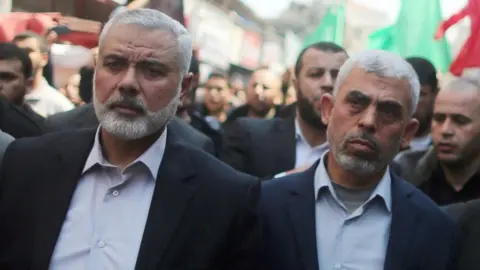 Reuters
ReutersSinwar had disappeared at the start of the war and, before the chance encounter in which he was killed, it was assumed he had spent much of the conflict hiding in tunnels beneath Gaza.
It is not yet clear who will replace him as the leader of Hamas.
Several other top commanders of Hamas have been killed by Israel since the war began.
As a result of the conflict, the group’s infrastructure and ability to operate openly in the Gaza Strip have been all but destroyed.
Its most prominent leaders now include Khaled Meshaal, who heads Hamas’s relations with Palestinian communities abroad and lives in Qatar, and Mahmoud Zahar, one of the group’s founders, who lives in Gaza.
Hamas’s most important allies are Iran – its biggest backer in terms of funds, weapons and political support – and Syria and Qatar.
Why did Hamas attack Israel?
Hamas led the deadliest attack on Israel in its history, killing about 1,200 people, including more than 360 young people at a music festival.
The unprecedented attack sent shockwaves across the country, as Hamas gunmen targeted border communities for hours and took hostages.
Hamas has said it is a resistance movement. It has described the attack as a response to what it says are decades of Israeli oppression, the killings of Palestinians and years-long blockade of the Gaza Strip.
As Israel prepared to mark a year since the attack, Khalil al-Hayya, the most senior leader outside Gaza, justified it by saying it had put the plight of the Palestinians on the world’s political agenda.
“It was necessary to raise an alarm in the world to tell them that here there is a people who have a cause and have demands that must be met,” he told the BBC’s Jeremy Bowen.
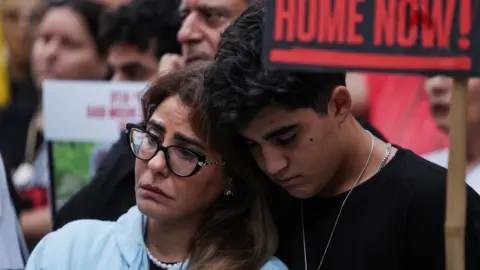 Reuters
ReutersHamas has also said the attack was a reaction to what it claims are Israeli efforts to take over the al-Aqsa mosque compound in Jerusalem – Islam’s third holiest site. Hamas also wants the release of thousands of Palestinians in Israeli prisons.
The year leading up to the attack was also the deadliest in the occupation of the West Bank, since the UN began recording in 2005. By the end of the year at least 505 Palestinians had been killed there, mostly by Israeli soldiers and settlers. In the same year, 30 Israelis were also killed in the West Bank.
All Palestinian factions and parties oppose Israel’s presence in the West Bank, as well as occupied East Jerusalem and the Gaza Strip. They want the land to be part of a future independent state, something backed by the vast majority of the international community.
Israel’s occupation of the land and settlements it has built there are considered illegal by the UN’s top court. However, Israel’s current government does not recognise the right of the Palestinians to have their own state, arguing that it would be a security threat. It also claims the West Bank as part of a “Greater Israel”.
Analysts have suggested the attack could also have been timed to derail recognition of Israel by Saudi Arabia, which was considered likely at the time.
What was Israel’s response to Hamas’s attacks?
Israel launched a massive military offensive against Hamas in Gaza following the 7 October attack. It started with air strikes and was followed by a ground invasion.
The two sides have been at war ever since.
Israeli Prime Minister Benjamin Netanyahu says Israel aims to destroy Hamas, to return the remaining hostages and to make sure Israel cannot be threatened in future.
It also wants tens of thousands of displaced Israelis to be able to return to their homes in northern Israel, near the border with Lebanon, which is under attack from Hamas’s ally Hezbollah.
More than 41,600 people in Gaza – mostly civilians, the majority of whom were women and children – have been killed in the fighting, according to the Hamas-run health ministry.
The UN says most of the 2.3 million population have been forced from their homes and that there are “catastrophic” levels of food insecurity.
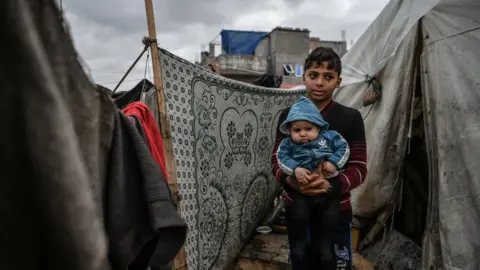 Getty Images
Getty ImagesMore than 340 Israeli soldiers have been killed in the fighting, the Israeli military says.
Both Israel and Hamas have been accused of committing war crimes and human rights abuses.
The UN Human Rights Council says both sides have mounted attacks against civilian populations and are responsible for “murder or wilful killings”. Both have rejected the report’s findings.
Israel has also been accused of genocide in a case brought by South Africa and taken to the UN’s top court, the International Court of Justice. Israel says the case is “wholly unfounded”.
There was one week-long ceasefire in November 2023 but attempts to broker another one have failed.
Have Israel and Hamas fought before?
Since its founding, Hamas has carried out bombings, rocket attacks and shootings, killing civilians and soldiers in Israel.
Israel has carried out operations against Hamas in Gaza and its cells in East Jerusalem and the West Bank, killing its fighters. In such operations, Israel has killed many Palestinian civilians.
The two sides have also fought several major conflicts – in 2008-09, 2012 and 2014.
The last major conflict between the two sides was in May 2021, which ended in a ceasefire after 11 days.
Every round of fighting has seen people killed on both sides, the vast majority of them Palestinians in Gaza.
Where is the Gaza Strip and how big is it?
The Gaza Strip is a 41km (25-mile) long and 10km-wide territory between Israel, Egypt and the Mediterranean Sea.
It was part of a proposed Arab state under the original UN partition plan in 1947. Gaza was then occupied by Egypt in the war that followed Israel’s creation, then captured by Israel during the 1967 Six-Day War.
Israel withdrew its troops and about 7,000 settlers from the territory in 2005, though the UN still considers the land to be occupied.
Gaza is one of the world’s most densely populated places.

Just over three-quarters of its population are registered refugees, or descendants of refugees, the UN says.
Even before the current war between Israel and Hamas, the territory had one of the highest unemployment rates in the world, with most of its population living below the poverty line and depending on food aid to survive.
Israel controls Gaza’s airspace, its shoreline and the shared border. It also limits the movement of people and goods.



